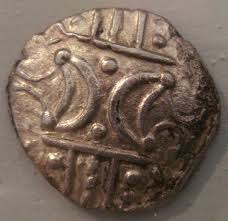It looks like you're using an Ad Blocker.
Please white-list or disable AboveTopSecret.com in your ad-blocking tool.
Thank you.
Some features of ATS will be disabled while you continue to use an ad-blocker.
share:
a reply to: urbanghost
Well yea you don't want to shock the locals right off. Got to bring them in slow to Romanization.
I suppose these Cats helped the Romans out with the tribes that wouldn't go along, just like in Thrace.
What do you make of all the Thracian icons on many of these coins?
Well yea you don't want to shock the locals right off. Got to bring them in slow to Romanization.
I suppose these Cats helped the Romans out with the tribes that wouldn't go along, just like in Thrace.
What do you make of all the Thracian icons on many of these coins?
a reply to: Logarock
I don't now much about them, but I now that the celtic lands bordered onto The Thracian, so with trading, ideas and art would have been swapped or copied between them. Even if they were at war this would have happened, after battles they would have taken things from the defeated armies, like weapons and jewellery and possibly gold coins if they had them.
What do you make of all the Thracian icons on many of these coins?
I don't now much about them, but I now that the celtic lands bordered onto The Thracian, so with trading, ideas and art would have been swapped or copied between them. Even if they were at war this would have happened, after battles they would have taken things from the defeated armies, like weapons and jewellery and possibly gold coins if they had them.
originally posted by: Logarock
originally posted by: urbanghost
originally posted by: Logarock
Even the names of some of these British tribes and kings sound Greek with the "us/as" suffix.
Leonidas. -Greek
Tasciovonus, Epaticcus, Cumbelinus.....British.
And this Brits had no writing before Rome deal. Then what is all this writing on these coins? Time to really dig into Wilson for me.
They have latin names as they are the names given to them by the romans, there are other names for them. For instance Cunobeline or Cunobelin is called Cynfelyn in the Welsh manuscripts.
It could be, just a thought, that these were there names and the Welsh just translated them into their own language the best they could. I am just postulating that based on my idea about transplants from other parts of the Empire who understood how things were done on both sides. For instance it looks rather clear to me that Cunobline and his dad were puppets. Just a thought yet.
It's a bit reminiscent of our Carthimandua, who gave up Caratacus to Rome. The alliances between the celtic tribes -and I'm including the Romans -is complicated and fluid.
As to the Milesians however, they're listed as the next wave of arrivals in Ireland after the Tuatha de Danaan in the Lebor Gabala Erenn, another document of mediaeval Britain, which has been discredited as myth and pseudo-history.
The Firbolg, who were there before the Tuatha, are known as the 'men of bags', after the clay they carried in bags. That's a strange attribute, but common in Babylon...
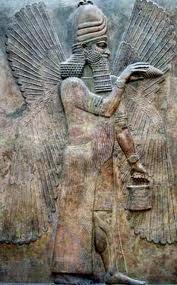
a reply to: urbanghost
I am talking only about those Thracians that were Celts. There was period of Celtic rule over that area. And apparently be they organic or not to the Celts there, the icons were transferred to Britain. The Welsh Dragon being the one that stands out the most. There is no reason to believe it was not a Celtic royal icon in Thrace as well.
If you read in one of the above posts it talks about the very earliest coins in Britain were mimics of Greek and Macedonian coins.
I am talking only about those Thracians that were Celts. There was period of Celtic rule over that area. And apparently be they organic or not to the Celts there, the icons were transferred to Britain. The Welsh Dragon being the one that stands out the most. There is no reason to believe it was not a Celtic royal icon in Thrace as well.
If you read in one of the above posts it talks about the very earliest coins in Britain were mimics of Greek and Macedonian coins.
a reply to: urbanghost
And yet we have the coin posted above found in Britain, 2 of them in fact with the raised arm, winged thing.....late 1st century BC. And the only other place those are found is in Abdera Thrace, Greece.
Well where did it come from and why is it on the flag? It just popped up in the 8th century from no where? Just asking. I just showed antecedence for the thing. Are you telling me some guy on a net blog was the first on to ever notice that this Tasciovonus had that dragon on his coins?
And yet we have the coin posted above found in Britain, 2 of them in fact with the raised arm, winged thing.....late 1st century BC. And the only other place those are found is in Abdera Thrace, Greece.
Well where did it come from and why is it on the flag? It just popped up in the 8th century from no where? Just asking. I just showed antecedence for the thing. Are you telling me some guy on a net blog was the first on to ever notice that this Tasciovonus had that dragon on his coins?
a reply to: Logarock
It is supposed to have been the battle flag of King Arthur, it has only been on the flag of wales since 1959. Most of the old Welsh flags have lions on them.
They look more like Griffins.
And yet we have the coin posted above found in Britain, 2 of them in fact with the raised arm, winged thing
Well where did it come from and why is it on the flag?
It is supposed to have been the battle flag of King Arthur, it has only been on the flag of wales since 1959. Most of the old Welsh flags have lions on them.
edit on 2-5-2014 by urbanghost because: (no reason given)
a reply to: urbanghost
Arthur yes, I wonder if he is related to Art the old Irish king.
Do you know why it was chosen for the flag? A griffin is just a dragon with a beak and we must give some room for artistic evolution here. And Isnt Griffin a well populated Welsh name?
Oh I just remembered. It must have been adopted because some wizard, forget his name but don't believe it was Merlin, said that the White Dragon of the Saxons would overtake the Red Dragon of the British. He had a "vision" and saw this. And I do believe he was a saxon wiz. Cant remember those details.
Anyway its the Welsh way of saying UP YOURS!
Arthur yes, I wonder if he is related to Art the old Irish king.
Do you know why it was chosen for the flag? A griffin is just a dragon with a beak and we must give some room for artistic evolution here. And Isnt Griffin a well populated Welsh name?
Oh I just remembered. It must have been adopted because some wizard, forget his name but don't believe it was Merlin, said that the White Dragon of the Saxons would overtake the Red Dragon of the British. He had a "vision" and saw this. And I do believe he was a saxon wiz. Cant remember those details.
Anyway its the Welsh way of saying UP YOURS!
originally posted by: Logarock
a reply to: urbanghost
Do you know why it was chosen for the flag?
A griffin is just a dragon with a beak and we must give some room for artistic evolution here. And Isnt Griffin a well populated Welsh name?
It must have been adopted because some wizard, forget his name but don't believe it was Merlin, said that the White Dragon of the Saxons would overtake the Red Dragon of the British. He had a "vision" and saw this. And I do believe he was a saxon wiz.
It was used on the flags after the Gorsedd of Bards in Wales urged the government to use it.
A griffin and a dragon are totally different, the greeks had legends about both.
Griffin is an Irish name, Griffiths is welsh.
It wasn't anything to do with a Saxon wizard. It comes from the story of Lludd and Llefelys in the mabinogion. Ludd was the son of Beli, King of Britain and is a Welsh hero. Three plagues befell Britain, the first the Coraniaid. They were a race of Dwarfs. The second was a terrible scream that came every May-day and caused all pregnant women to miscarry. The third plague was provisions that disappeared.
LLudd went to france to see his brother who had married a princess and became king of france. His brother tells him how he can stop the plagues. He reveals that the terrible scream is a Red Dragon that is in combat with an invading White Dragon. He gives the dragons mead to make them fall asleep, then he locks them in a stone chest and buries it underground. It is supposed to be buried at Dinas Emrys.
the story continues many years later when the wizard Myrddin, Merlin, who was just a boy prophesises of a long fight between a red dragon and a white dragon, when king Vortigen tries to build a castle on the Dinas Emrys and it keeps getting destroyed every night.
he digs the dragons out and sets them free and the Red Dragon eventually defeats the White Dragon and Myrddin tells him that the white dragon represents the Saxons.
edit on 2-5-2014 by urbanghost because: (no reason given)
originally posted by: beansidhe
Just going to stick this here before I go. It's the back-to-back crescent again. Not identical, but close, from a coin of the Iceni:
There is another coin from Wales with the double crescent on it. This one is from the Catuvellaunian tribe.
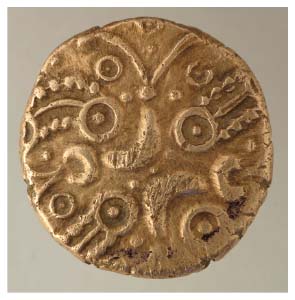
a reply to: urbanghost
See, I wasn't to far off.
Griffin is Irish like Walsh. Its all in the accent. lol
I need to get over there one of these days check out all the castles and Owain statue, check out the Bryn Gwyn, take in a Iwan show and sing with the boys!
See, I wasn't to far off.
Griffin is Irish like Walsh. Its all in the accent. lol
I need to get over there one of these days check out all the castles and Owain statue, check out the Bryn Gwyn, take in a Iwan show and sing with the boys!
I love this thread and I am currently sitting on the sidelines, checking out all this Welsh stuff.
a reply to: urbanghost
Just a thought I had...
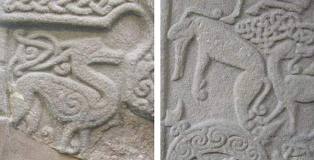
That's from one of our Pict stones and it's a pretty good match to the coins from Thrace. Check out the coin dragon's 'hair' -it's Pictish swirls.
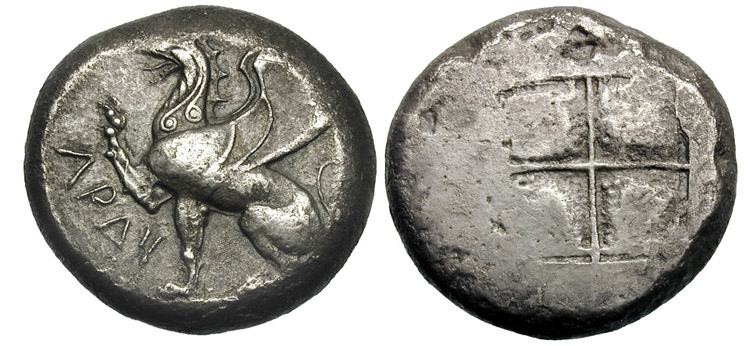
The Votadini clan -the Gododdin -the folk around the Scottish Borders area, spoke Welsh - they left their poem, anyway so we think they did. The Picts were well aquainted with them, either through battering them or forging alliances at different times. It's possible they took the dragon emblem to Wales...(ducks).
Check some of your Welsh stones - it'd be interesting to see if there are dragon motifs there.
Just a thought I had...

That's from one of our Pict stones and it's a pretty good match to the coins from Thrace. Check out the coin dragon's 'hair' -it's Pictish swirls.

The Votadini clan -the Gododdin -the folk around the Scottish Borders area, spoke Welsh - they left their poem, anyway so we think they did. The Picts were well aquainted with them, either through battering them or forging alliances at different times. It's possible they took the dragon emblem to Wales...(ducks).
Check some of your Welsh stones - it'd be interesting to see if there are dragon motifs there.
In fact I'll save you the trouble:
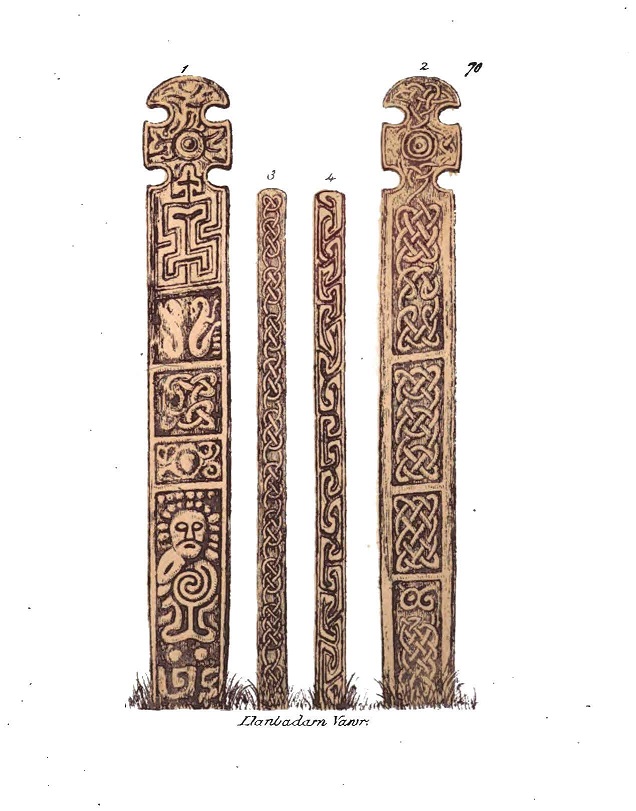
There are some, with their arm raised up high. Hard to know without a photo whether they're Thracian dragons, Dacian dog-headed fish monsters or Etruscan sea horses, but because of their high arm, I'm going with dragon.

There are some, with their arm raised up high. Hard to know without a photo whether they're Thracian dragons, Dacian dog-headed fish monsters or Etruscan sea horses, but because of their high arm, I'm going with dragon.
In fact, look at the man with the 'spiral stomach' at the bottom of the 'dragon stone'. That's the first time I've seen that since the
inexplicable figure (bottom right) on the 'Samson' stone:
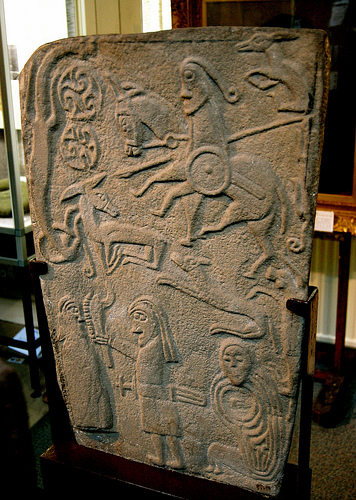

This wiki's not great, but you'll get the idea:
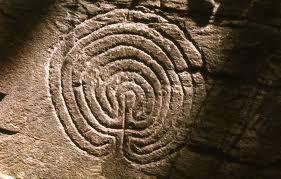
Other explanations talk of labyrinths being used as a way of communing with God, metaphors for meeting God, spiritual journeys etc...
Celtic labyrinths are found among carvings at Camonica Valley, occupied by the Celts early in the first millennium, most older than the one Knossos or Classical style example found there. The mythology associated with the labyrinths also suggest Celtic origin. For example, the labyrinths containing eyes or a figure with horns and a snake about its waist imply the deity Cernunnos. Lastly, Celtic examples resembling the Cretan model but featuring path-line reversal (the path of one is traceable as the line of the other) suggest Celtic pre-knowledge of their construction.

Other explanations talk of labyrinths being used as a way of communing with God, metaphors for meeting God, spiritual journeys etc...
a reply to: beansidhe
Dragons are rarely found in celtic art, there are loads of dogs, snakes, birds and fish, but few dragons. In Britain only pictish art shows them. When they are depicted in celtic art they usually follow this design.
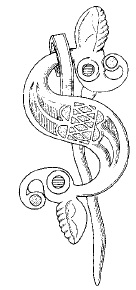
The animals on the coins look more like this, a griffin, found quite a lot in welsh art.
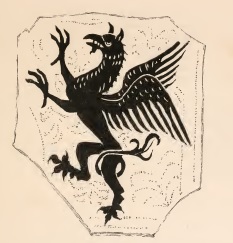
The animals on the welsh cross only have two legs and a tail. They are most probably sea monsters, if they had wings I would agree they were dragons. When that drawing was done they had a tendency to embellish them . Like was done to this one. The first picture is from when it was first described, the second what it really looks like.
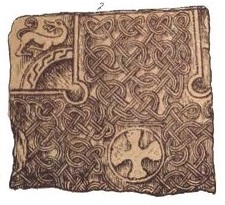
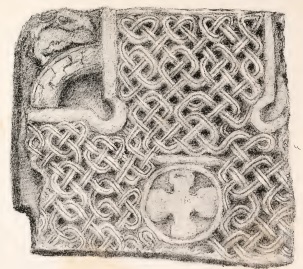
Dragons are rarely found in celtic art, there are loads of dogs, snakes, birds and fish, but few dragons. In Britain only pictish art shows them. When they are depicted in celtic art they usually follow this design.

The animals on the coins look more like this, a griffin, found quite a lot in welsh art.

The animals on the welsh cross only have two legs and a tail. They are most probably sea monsters, if they had wings I would agree they were dragons. When that drawing was done they had a tendency to embellish them . Like was done to this one. The first picture is from when it was first described, the second what it really looks like.


new topics
-
This is adorable you guys!
General Chit Chat: 6 hours ago -
Reprehensible Behavior
US Political Madness: 6 hours ago -
Defending the need for adherence to Old Testament commandments under the new covenant of Christ
Conspiracies in Religions: 8 hours ago
top topics
-
Reprehensible Behavior
US Political Madness: 6 hours ago, 10 flags -
Those Drones over NJ and elsewhere
Aliens and UFOs: 12 hours ago, 8 flags -
South Korean coup was an attempt to start WW3
World War Three: 12 hours ago, 7 flags -
This is adorable you guys!
General Chit Chat: 6 hours ago, 7 flags -
Archer aviation and the NJ drones
Aircraft Projects: 12 hours ago, 5 flags -
Defending the need for adherence to Old Testament commandments under the new covenant of Christ
Conspiracies in Religions: 8 hours ago, 5 flags
active topics
-
Drones everywhere in New Jersey ---and Elsewhere Master Thread
Aliens and UFOs • 171 • : nugget1 -
Post A Funny (T&C Friendly) Pic Part IV: The LOL awakens!
General Chit Chat • 7912 • : imitator -
This is adorable you guys!
General Chit Chat • 4 • : CriticalStinker -
The Acronym Game .. Pt.4
General Chit Chat • 1016 • : FullHeathen -
Could rampant land speculation have caused the Civil War?
History • 35 • : matafuchs -
George Stephanopoulos and ABC agree to pay $15 million to settle Trump defamation suit
Mainstream News • 23 • : Brotherman -
Pelosi injured in Luxembourg
Other Current Events • 45 • : rickymouse -
Nov 2024 - Former President Barack Hussein Obama Has Lost His Aura.
US Political Madness • 19 • : Connector -
Sky Intruders - Drones, Deception & One Weird UFO Video : Weaponizes : Episode #62
Aliens and UFOs • 7 • : DontTreadOnMe -
They Know
Aliens and UFOs • 97 • : DontTreadOnMe

